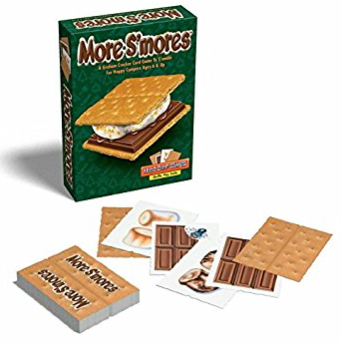 |
More S'mores is a fun game for a summer's eve. |
Object:
Score the most points.
Set up:
Set 10 graham cracker cards on a pile off to the side. This is the "cracker pile". Shuffle and deal evenly the rest of the cards, face-down, between players. Players stack their cards, face-down, in front of them. Take one card from the cracker pile and place it in the middle of the table. This is the bottom of a s'mores.
Play:
The first player will turn over his top card and place it on the graham cracker card in the middle of the table. You are now building a s'mores. Players take turns placing one card at a time on the stack. When another graham cracker card is turned up and is placed on the stack, one s'mores is complete and the player takes the s'mores. He then takes a graham cracker from the cracker pile, places it in the middle of the players, and this starts the second s'mores. Players continue in this manner, placing one card at a time, until all 10 s'morses have been made and claimed. At this time players will add up all the points they have made from the s'mores they have collected and the player with the most points is the winner.
Point values are as follows:
Graham cracker cards - 1 point each
Toasted marshmallow cards - 3 points each
Chocolate bar cards - 3 points each
Burnt marshmallow cards - subtract 5 points (-5)
Chocolate-eating any cards - subtract 5 points (-5)
Try this:
- Hold the cards in the non-dominant hand to deal. Push each card off the top with the thumb and take with the dominant hand to deal.
- Separate and lift each card off the top of the stack without disturbing the rest of the stack.
- Sort the cards into piles of like cards. Either hold them in the non-dominant hand, pushing them off one at a time with the thumb, or place the deck on the tabletop and lift each card off the top of the deck, disturbing the others as little as possible.
- Skip the game and make 10 complete s'mores by placing the cards in piles according to how traditional s'mores are assembled: graham cracker, chocolate bar, toasted marshmallow, graham cracker.
- Work
on visual discrimination, manual dexterity, bilateral integration,
eye-hand coordination, in-hand manipulation, shuffling/dealing cards, executive functioning
skills, process skills, socialization skills, play and leisure
exploration and participation
- In the box: 20 graham cracker cards, 10 toasted marshmallow cards, 10 chocolate bar cards, 5 burnt marshmallow cards, 5 chocolate-eating ant cards


